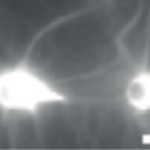Direct measurement of near-nano-Newton forces developed by self-organizing actomyosin fibers bound α-catenin
Authors
Sonam S, Vigouroux C, Jégou A, Romet-Lemonne G, Le Clainche C, Ladoux
B, Mège RM.
Editors
Biol Cell.
2021 Jul 20
Abstract
 Actin cytoskeleton contractility plays a critical role in morphogenetic processes by generating forces that are then transmitted to cell–cell and cell-ECM adhesion complexes. In turn, mechanical properties of the environment are sensed and transmitted to the cytoskeleton at cell adhesion sites, influencing cellular processes such as cell migration, differentiation and survival. Anchoring of the actomyosin cytoskeleton to adhesion sites is mediated by adaptor proteins such as talin or α-catenin that link F-actin to transmembrane cell adhesion receptors, thereby allowing mechanical coupling between the intracellular and extracellular compartments. Thus, a key issue is to be able to measure the forces generated by actomyosin and transmitted to the adhesion complexes. Approaches developed in cells and those probing single molecule mechanical properties of α-catenin molecules allowed to identify α-catenin, an F-actin binding protein which binds to the cadherin complexes as a major player in cadherin-based mechanotransduction. However, it is still very difficult to bridge intercellular forces measured at cellular levels and those measured at the single-molecule level.
Actin cytoskeleton contractility plays a critical role in morphogenetic processes by generating forces that are then transmitted to cell–cell and cell-ECM adhesion complexes. In turn, mechanical properties of the environment are sensed and transmitted to the cytoskeleton at cell adhesion sites, influencing cellular processes such as cell migration, differentiation and survival. Anchoring of the actomyosin cytoskeleton to adhesion sites is mediated by adaptor proteins such as talin or α-catenin that link F-actin to transmembrane cell adhesion receptors, thereby allowing mechanical coupling between the intracellular and extracellular compartments. Thus, a key issue is to be able to measure the forces generated by actomyosin and transmitted to the adhesion complexes. Approaches developed in cells and those probing single molecule mechanical properties of α-catenin molecules allowed to identify α-catenin, an F-actin binding protein which binds to the cadherin complexes as a major player in cadherin-based mechanotransduction. However, it is still very difficult to bridge intercellular forces measured at cellular levels and those measured at the single-molecule level.


